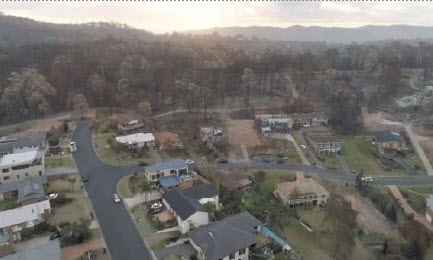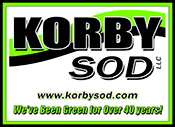What Can Your Turf Do For You and The Environment?
At Korby Sod, we are trying to get the information out about the positive and healthy benefits that a good, well-maintained law can provide you and your family. Along with this information, we provide great DIY and proper care information to help improve your lawn and reduce water use while maintaining a beautiful landscape. We hope to help our community members understand the importance of keeping turf in areas where it is beneficial to the environment, rather than settling on the unproven idea that putting in seed or sod is ecologically damaging.
You can find our support and DIY page here –https://korbysod.com/resources/
Below are just a few facts and resources to help our customers understand the important impacts that a growing, healthy turf has on the environment and community.
Oxygen Production and Carbon Dioxide Sequestration:
● The oxygen needed to meet all of the requirements for one adult each day is produced by only 25-square-feet of healthy turfgrass lawn. 1
● Carbon modeling research of a typical suburban home on a half-acre lot that contains a landscape with beds, shrubs, trees, and a grass lawn indicates that between 81% and 90% of the carbon captured in the landscape is captured by the lawn. 4
● Lawns also annually take in and store about 5 percent of the carbon dioxide in the earth’s atmosphere, which helps reduce the potential for global warming. Hardscapes do not! 2
● It might not be a well-known fact, but lawns and actively growing turf can produce more oxygen per area than trees. One acre full of tree canopy produces enough oxygen for 8 to 18 people, whereas one acre of turf cover can produce enough for 120-290 people! 3,4
Rainfall, Soil Erosion, Fire Suppression:
● Depending on soil type, an average lawn of 2,500 S.F. can help capture and avoid runoff of 1,000-12,500 gallons of water. 4
● According to scientific research published by MDPI, “Grassroots improve soil shear strength, increase soil organic matter, and effectively reduce soil detachment [20,21,22]. Grass surface cover can protect the soil surface from raindrop splashing [23]. Hence, grass planting is a great measure in controlling soil erosion”. 5
● One study showed that a healthy ryegrass stand could reduce soil erosion by up to 92% and decrease sediment transport rate by 96%. That is an incredible scientific fact that leads directly to safer, cleaner water delivery systems in our communities. 6
● Among many findings, this report from GHD for Horticulture Innovation Australia Limited displayed the difference between fire protection from artificial turf and real, live growing turf. This is a powerful study that found “Live turf is known operationally to both mitigate fire spread, and to provide defendable space to allow safe defense of properties. Lawns and walkways create firebreaks that interrupt the path of surface fire spread. Well-maintained lawns have low flammability and risk of ignition, and have been shown to remain intact even in the context of extreme bushfires which have occurred in Australia.” 7

Figure 6 Tathra (NSW) following brushfires in 2018 (Source: Clubs NSW 2019)
In 2018, Tathra (NWS) was subjected to a high-intensity brushfire that approached from the west
through the forest, but as shown in Figure 6 above, has not spread across maintained lawns. rather, airborne
embers landing in pockets of fire-prone vegetation have resulted in the burning of some isolated garden beds,
while maintained lawns remain largely intact. 7
Impacts on Homeowners:
● In warmer times of the year, heat that is built up at ground level during the day dissipates in night. A lawn or yard that is completely covered in a tree canopy can act like a greenhouse and trap heat lower to the earth, reducing the natural cooling of a home at night. Having a mix of turf and trees is the best way to protect day and night heating and cooling. 8
● It takes some forward-thinking and science to make a proven impact. Greg Ingleton, business development manager for environmental opportunities for SA Water in scorching South Australia, got local government officials to stop having citizens eliminate watering their lawns in the summer. The reason is because of the natural cooling (evapotranspiration) effect lawns have on the surrounding environment. A small uptick in water, they found, saved them much more in electricity due to lower A/C bills as well as an increase in the outdoor activities for the family.
● In California, only 9% of the water usage comes from homes, parks, sports fields, and golf courses (reported by the Department of Water Resources). Even in times of drought, reducing that use by 20% makes a little impact on the State of California’s overall water use. The trend to remove turf is a knee-jerk reaction without thinking of all of the benefits it brings. Lawns offset 50% of solar heat through cooling evaporation. On hot, sunny days the air temperature over lawns can stay 10-14 degrees cooler than the climate directly above concrete and asphalt. This has a direct impact on the heat absorbed/released by your home. 1, 10
● For every $1.00 a homeowner invests in their landscaping, they see up to $1.35 in return on value. That’s great equity. Plus, homes that are next to parks, natural areas, and open spaces have much higher (8-20%) value as compared to similar homes in the same half-mile area.
While no study or scientific finding exactly describes every situation, there is a lot of evidence that supports the idea of keeping healthy, thriving turf areas. Turfgrass provides a lot of oxygen, sequesters carbon, aides in erosion control, keeps an amazing fire barrier, increases home value and reduces A/C use and electrical energy bills. Yes, it takes water to grow, but so does everything living. California has a large, diverse array of landscape and only 9% of the total water use is for homes, parks, sports fields and golf courses. The issue isn’t using too much water to make turf a viable option for landscapes. The benefits of natural grass are scientifically proven. We, as a community, need to do a better job of using our water efficiently and effectively so the benefits of turf can come at a minimal impact to our water storage and delivery systems.
- Maryland Institute of Applied Agriculture, “Maryland Turfgrass Survey: An Economic Value Study,” University of Maryland, 1996.
- Qian, Y. L., R. Follett and J. Kimble, “Assessing Soil Carbon Sequestration in Turfgrass Systems Using Long-Term Soil Testing Data,” Soil Science Society of America Journal, 2010
- David J. Nowak, Robert Hoehn, and Daniel E. Crane, “Oxygen Production by Urban Trees in the United States” Arboriculture and Urban Forestry, 2007
- The Lawn Institute – Science/Education/Environment: Oxygen Production
- Youngcai Lou et. al. “Effects of Distributions of Grass Strips on Soil Erosion in Spoil Tips” Yangling, Xianyang China, Mar 15, 2022 .
- Yuequn Dong et. al. “Effects of rye grass coverage on soil loss from loess slopes” International Soil and Water Conservation Research: Volume3, Issue3, Sept. 2015
- GDH – Horticulture Innovation Australia Limited “Living turf fire benefits study – Literature review” April, 2020
- Science Daily.com – Science News “Trees and lawns beat the heat” University of Utah. October 13,2020
- The Fifth State “Letting your lawn die off? Think again if you want to stay cool” Environment. February 27, 2020
- The Press-Enterprise “CALIFORNIA DROUGHT: Grass may keep yards cooler” May, 13 2015
- Zachary S. Johnson, Tony Koski, Alison Stoven O’Connor “The Hidden Value of Landscapes: Implications for Drought Planning” Colorado State University.
We Serve More Than Just Colorado
Our Colorado-based sod farm serves more than just the Colorado front range!
Our sod services spread into Wyoming, South Dakota, New Mexico and more.
Get a Free Sod Quote Today
Happy to Help! (970) 568-7633
Wellington: (970) 568-7633 (Phone or Text)
Denver: (720) 262-3818 (Phone or Text)
Toll Free: (844) 285-5606.
Top Notch sod Delivery, sod installation, Professional Experience, Convenient Pickup Service.
